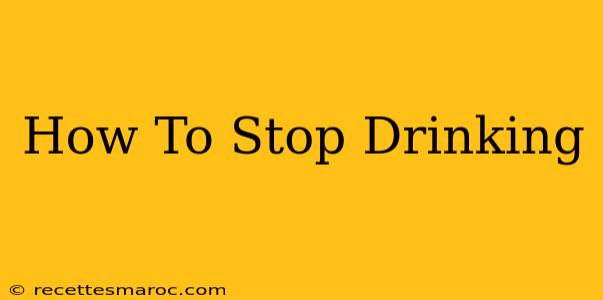Stopping drinking alcohol can be a challenging but incredibly rewarding journey. Whether you're looking to cut back, take a break, or quit altogether, this guide provides practical steps and resources to help you achieve your sobriety goals. It's crucial to remember that everyone's path to sobriety is unique, and what works for one person may not work for another. Be patient with yourself, celebrate your successes, and don't be afraid to seek support.
Understanding Your Drinking Habits
Before you embark on your journey to stop drinking, it's essential to understand your relationship with alcohol. Ask yourself these questions:
- How much do you drink? Tracking your consumption – even for a short period – can be eye-opening. Use a journal or app to record the amount and type of alcohol you consume daily or weekly.
- Why do you drink? Are you using alcohol to cope with stress, anxiety, or loneliness? Identifying your triggers is crucial for developing coping mechanisms.
- What are the consequences of your drinking? Consider the impact on your physical and mental health, relationships, and work or studies.
Creating a Plan for Sobriety
Stopping drinking cold turkey can be extremely difficult and potentially dangerous, especially if you're a heavy drinker. It's best to develop a gradual and personalized plan. Here's a step-by-step approach:
1. Set Realistic Goals
Don't try to change everything overnight. Start with small, achievable goals, such as reducing your drinking frequency or limiting the amount you consume per occasion. Small wins build momentum and confidence.
2. Seek Support
This is arguably the most important step. Talk to your doctor, a therapist, or a trusted friend or family member about your decision. Consider joining a support group like Alcoholics Anonymous (AA) or SMART Recovery. Having a support system is vital for staying on track.
3. Identify and Manage Triggers
Understanding what situations or emotions lead you to drink is key. Once you've identified your triggers, develop coping strategies, such as meditation, exercise, or spending time with supportive friends and family.
4. Find Healthy Alternatives
Replace alcohol with healthy habits. Exercise, hobbies, spending time in nature, and engaging in creative activities can help you stay occupied and reduce cravings.
5. Practice Self-Care
Prioritize self-care activities that nourish your mind and body. This might include getting enough sleep, eating nutritious foods, and practicing mindfulness. Taking care of yourself is essential for managing cravings and staying motivated.
Dealing with Withdrawal Symptoms
If you're a heavy drinker, stopping abruptly can lead to uncomfortable or even dangerous withdrawal symptoms. These can include:
- Anxiety
- Shaking
- Sweating
- Nausea
- Seizures (in severe cases)
It's crucial to seek medical advice if you experience severe withdrawal symptoms. Your doctor can recommend medication or other interventions to help you manage withdrawal safely and comfortably.
Maintaining Long-Term Sobriety
Sobriety is a journey, not a destination. Maintaining long-term sobriety requires ongoing commitment and effort. Here are some tips for staying on track:
- Continue to seek support: Attend support group meetings regularly, and talk to your therapist or sponsor when needed.
- Develop coping mechanisms: Practice your coping strategies regularly to manage stress and cravings.
- Celebrate your successes: Acknowledge and celebrate your milestones, no matter how small.
- Be kind to yourself: Setbacks are normal. Don't beat yourself up if you slip up; learn from it and get back on track.
Stopping drinking is a significant accomplishment that will positively impact all aspects of your life. With the right support and strategies, you can achieve your sobriety goals and live a healthier, happier life. Remember, you are not alone. Help is available.
Keywords:
stop drinking, quit drinking, alcohol addiction, alcoholism, sobriety, alcohol withdrawal, detox, recovery, support groups, AA, SMART Recovery, coping mechanisms, triggers, relapse prevention, healthy lifestyle, mental health, physical health, addiction treatment
This article incorporates various SEO best practices including keyword optimization (natural keyword density), use of headings (H2, H3) for better readability and structure, bold and strong text for emphasis, and a dedicated keywords section for improved search engine visibility. It also focuses on user engagement by providing practical advice and a supportive tone.

